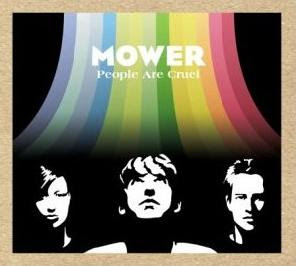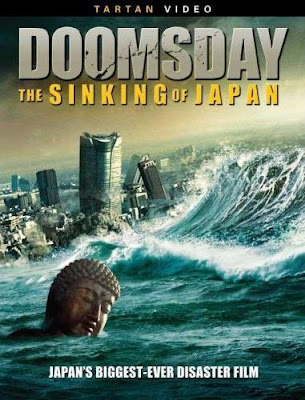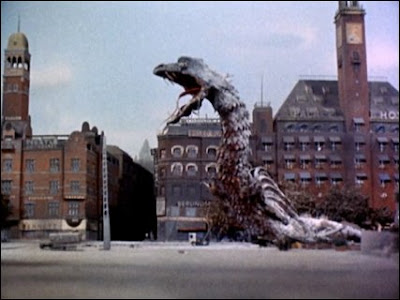
CURSE OF THE GOLDEN FLOWER
(2006, Hong Kong/China, IMDB: Man cheng jin dai huang jin jia)
Opening in UK cinemas on April 13th.
Recommended - a highly entertaining epic costume drama
In Phuket, an island off the west of Thailand, I went to see the new epic from Zhang Yimou, the director of House of the Flying Daggers and Hero. It was dubbed in Thai with English and Chinese subtitles.
The story begins as a high-powered drama, where all is not well between the Emperor of China, the Empress and their three sons. The Empress’ health is failing, but this doesn’t stop her from trying to continue a relationship with her son, who’s just returned from war.
As the implications of their secret relationship escalate, the royal house is thrown into full-scale battle, with itself.

The film begins by introducing us to the all the characters in the impeccably lush rainbow-coloured interior of the Emperor’s palace. After a relatively low-key start, the films first action scenes immediately impress.
 I loved the black-clad warriors most of all, (with similar skills to Japanese ninja), whose weapons are flying scimitars on chains! Also used as grappling hooks, these silent killers can also anchor in the ground, allowing the warriors to attack from clifftops and sail down the chains on hollow bamboo grips.
I loved the black-clad warriors most of all, (with similar skills to Japanese ninja), whose weapons are flying scimitars on chains! Also used as grappling hooks, these silent killers can also anchor in the ground, allowing the warriors to attack from clifftops and sail down the chains on hollow bamboo grips.
But no one is as helpless as they appear. Every character seems to be an advanced master of martial arts. This may unintentionally amuse, as may some of the acting. As bad karma boomerangs on the baddies, emotions reach fever-pitch, but not too subtly. The exception here is Jay Chou who underplays as usual, showing little more range than his turn as the boy racer in Initial D – The Movie.

The battle scenes between the factions eventually fill the immense courtyard of the Emperor’s Palace, turning it into a huge, bloody chessboard. Aided by a multitude of computer graphic warriors, the action is still exciting and plot-driven.
I can’t tell you just how much of the epic action had been faked because the print I saw (in Thailand) was quite soft, but I still think there are many scenes that have been done large-scale with a traditional cast of thousands. All dressed in highly ornate colour-coded suits of armour, it’s imaginatively spectacular.
The acting and the operatic drama are enjoyably over-the-top - it seemed to complement the impossible fighting skills on display.




 Next up was a musical first as two mainstays of ZTT (Zang Tuum Tumb records, infamous for their Frankie Goes to Hollywood releases), played on stage for the first time ever. Claudia Brucken – lead singer of Propaganda (whose music has aged better than Frankie’s) and pianist Andrew Poppy. They played a quiet but powerful set, starting with a cover of Kate Bush’s Running Up That Hill, and then Roy Orbison’s In Dreams. Claudia’s underrated voice is evocative of the 80’s electro hits of Propaganda, but also of some beautiful solo releases in the 90’s. Her album Love and A Million Other Things, is a special favourite.
Next up was a musical first as two mainstays of ZTT (Zang Tuum Tumb records, infamous for their Frankie Goes to Hollywood releases), played on stage for the first time ever. Claudia Brucken – lead singer of Propaganda (whose music has aged better than Frankie’s) and pianist Andrew Poppy. They played a quiet but powerful set, starting with a cover of Kate Bush’s Running Up That Hill, and then Roy Orbison’s In Dreams. Claudia’s underrated voice is evocative of the 80’s electro hits of Propaganda, but also of some beautiful solo releases in the 90’s. Her album Love and A Million Other Things, is a special favourite. But Claudia was back on stage in a more lively incarnation, with her new band
But Claudia was back on stage in a more lively incarnation, with her new band  Throughout the evening, as the crew quickly but frantically re-rigged for the drastically different bands, Billy’s original music haunted the venue. On a projection screen at the back of the stage, many rare pop promos were playing that I’d not seen before. In the 80’s, the Associates were mainly on TV ‘live’ on Top Of The Pops or The Tube. The pop videos were rarely shown. Thankfully, much of this archive material is on YouTube at the moment, including a wonderful documentary/tribute made by Scottish TV, with interviews with many of Billy’s many collaborators – including Alan Rankine, Paul Haig and Yello.
Throughout the evening, as the crew quickly but frantically re-rigged for the drastically different bands, Billy’s original music haunted the venue. On a projection screen at the back of the stage, many rare pop promos were playing that I’d not seen before. In the 80’s, the Associates were mainly on TV ‘live’ on Top Of The Pops or The Tube. The pop videos were rarely shown. Thankfully, much of this archive material is on YouTube at the moment, including a wonderful documentary/tribute made by Scottish TV, with interviews with many of Billy’s many collaborators – including Alan Rankine, Paul Haig and Yello.










































